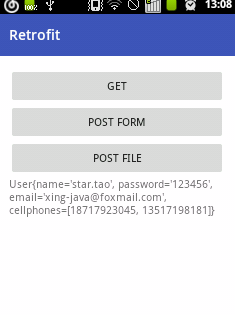Android网络请求框架Retrofit Android网络请求框架Retrofit详解
xing-java 人气:0介绍:
Retrofit 是Square公司开发的一款针对Android网络请求的框架,Retrofit2底层基于OkHttp实现的,OkHttp现在已经得到Google官方认可,大量的app都采用OkHttp做网络请求。本文使用Retrofit2.0.0版本进行实例演示。
使用Retrofit可以进行GET,POST,PUT,DELETE等请求方式。
同步请求:需要在子线程中完成,会阻塞主线程。
Response response = call.execute().body();
异步请求:请求结果在主线程中回调,可以在onResponse()回调方法进行更新UI。
call.enqueue(Callback callback)
使用步骤:
(1) 创建工程,添加jar:
compile 'com.squareup.retrofit2:retrofit:2.0.0' compile 'com.squareup.retrofit2:converter-gson:2.0.0' //这两个jar版本要一致,否则会有冲突
(2) 创建业务请求接口,具体代码如下
/**
* 创建业务请求接口
*/
public interface IUserService {
/**
* GET请求
*/
@GET("Servlet/UserServlet")
Call<User> getUser(@Query("email") String email);
/**
* POST请求
*/
@FormUrlEncoded
@POST("UserServlet")
Call<User> postUser(@Field("name") String name, @Field("email") String email);
}
解释说明:
@GET注解表示GET请求,@Query表示请求参数,将会以key=value(@Query注解参数名称为key,调用传进来的值为value)的方式拼接在url后面.
@POST注解表示POST请求,@FormUrlEncoded将会自动将请求参数的类型设置为application/x-www-form-urlencoded,@FormUrlEncoded注解不能用于Get请求。@Field注解将每一个请求参数都存放至请求体中,还可以添加encoded参数,该参数为boolean型,具体的用法为:
@Field(value = "password", encoded = true) String pwd
encoded参数为true的话,key-value-pair将会被编码,即将中文和特殊字符进行编码转换.
(3)创建Retrofit对象
Retrofit retrofit = new Retrofit.Builder()
.baseUrl(Constant.BASE_URL)
.addConverterFactory(GsonConverterFactory.create())
.build();
IUserService iUserService = retrofit.create(IUserService.class);
解释说明:
baseUrl()方法制定网络请求的固定绝对地址,一般包括请求协议(如Http)、域名或IP地址、端口号。
创建Retrofit实例时,若没有配置addConverterFactory(GsonConverterFactory.create())将会回调出JSON字符串,配置了将会回调实体对象。
支持的JSON解析库:
Gson: compile ‘com.squareup.retrofit2:converter-gson:2.0.1'
Jackson: compile ‘com.squareup.retrofit2:converter-jackson:2.0.1'
Moshi: compile ‘com.squareup.retrofit2:converter-moshi:2.0.1'
Protobuf: compile ‘com.squareup.retrofit2:converter-protobuf:2.0.1'
Wire: compile ‘com.squareup.retrofit2:converter-wire:2.0.1'
Simple XML: compile ‘com.squareup.retrofit2:converter-simplexml:2.0.1'
Scalars (primitives, boxed, and String): compile ‘com.squareup.retrofit2:converter-scalars:2.0.1'
(4) 调用请求方法,并得到Call实例
Call<ResponseBody> call = iUserService.getUser(xing-java@foxmail.com);
(5) 使用Call实例完成同步或异步请求
/**
* 发送GET请求
*/
private void getRequest() {
Retrofit retrofit = new Retrofit.Builder()
.baseUrl(Constant.BASE_URL)
.addConverterFactory(GsonConverterFactory.create())
.build();
IUserService iUserService = retrofit.create(IUserService.class);
Call<User> call = iUserService.getUser("xing-java@foxmail.com");
call.enqueue(new Callback<User>() {
@Override
public void onResponse(Call<User> call, Response<User> response) {
Log.i("MainActivity", "response = " + response);
User user = response.body();
resTxtView.setText(user.toString());
}
@Override
public void onFailure(Call<User> call, Throwable t) {
}
});
}
请求方式:
(1)GET 请求:
GET 请求返回 JSON 字符串:

GET 请求返回实体对象:

(2) POST发送表单:
/**
* 发送POST请求
*/
private void postRequest() {
Retrofit retrofit = new Retrofit.Builder()
.baseUrl(Constant.BASE_URL)
.addConverterFactory(GsonConverterFactory.create())
.build();
IUserService iUserService = retrofit.create(IUserService.class);
Call<User> call = iUserService.postUser("star.tao", "xing-java@foxmail.com");
call.enqueue(new Callback<User>() {
@Override
public void onResponse(Call<User> call, Response<User> response) {
}
@Override
public void onFailure(Call<User> call, Throwable throwable) {
}
});
服务端接收到的结果:

(3)文件上传:
private void uploadFile() {
Retrofit retrofit = new Retrofit.Builder()
.addConverterFactory(GsonConverterFactory.create())
.baseUrl(Constant.BASE_URL)
.build();
IUserService iUserService = retrofit.create(IUserService.class);
File file = new File("/sdcard/s.png");
RequestBody fileRequestBody = RequestBody.create(MediaType.parse("multipart/form-data"), file);
MultipartBody.Part multipartBody = MultipartBody.Part.createFormData("upload_file", file.getName(), fileRequestBody);
String desc = "this is file description";
RequestBody descRequestBody = RequestBody.create(MediaType.parse("multipart/form-data"), desc);
Call<ResponseBody> call = iUserService.uploadFile(descRequestBody, multipartBody);
call.enqueue(new Callback<ResponseBody>() {
@Override
public void onResponse(Call<ResponseBody> call, Response<ResponseBody> response) {
Log.i("debug", "upload success");
}
@Override
public void onFailure(Call<ResponseBody> call, Throwable t) {
}
});
}

加载全部内容